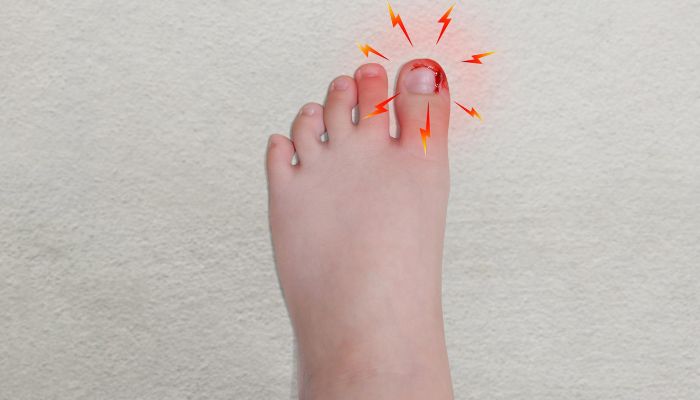
The mere mention of ingrown toenails might cause chills down your spine. That sharp edge of flesh at the sides of your toes, the throb calling for attention with every step—it’s enough to make a person wince.
Sure, such small cases, sometimes with just home remedies like soaking or trimming, would do. But what about that uncomfortableness which becomes painful? For that matter, professional help from the ingrown toenail clinic has to be availed.
The offered treatment options by the clinics are, of course, with the level of seriousness the ingrown toenail has reached. Let’s look at the most common practices that can be observed by healthcare practitioners.
Non-surgical Solutions:
Nail Lifting: In this approach, a podiatrist (foot specialist) numbs the toe and then uses sterile tools to carefully raise the ingrown edge of the nail. A small piece of cotton or splint is then placed underneath the lifted nail to encourage proper growth away from the skin. The procedure is generally painless, affords instant relief to the patient, and may prevent another ingrown.
Partial Nail Avulsion: In cases where the condition is not so easily treated, partial nail avulsion may be performed. The first thing the podiatrist does under this procedure is to anaesthetize your toe and then remove the part of the ingrown nail surgically using a special set of instruments. This procedure will sort out the immediate problem and substantially reduce the possibility of the nail growing again.
Surgical Procedures:
If the above-mentioned ingrown toenail treatment & removal approaches are insufficient in treating this condition, it should then be referred for minimally invasive surgeries.
Total Nail Avulsion: Full avulsion of a nail is done along with the affected toe. Though this may sound radical, that is generally the best solution to ongoing ingrown toenails. This involves completely numbing the toe at a podiatrist and continuing to remove the entire nail plate very carefully.
Chemical Matrixectomy: This is applied in very recalcitrant cases of an ingrown toenail. A chemical is applied over the root of the nail (matrix) that is responsible for the growth of nails. It may be applied in such a way that it destroys a small amount of the matrix but in the right manner, to avoid repeated occurrence of an ingrown toenail.
Additional Considerations:
Post-operative Care:
Proper recovery from an ingrown toenail treatment & removal surgery, in a nutshell, will contain religiously following your podiatrist’s instructions. This will usually include:
- Pain Management: If you have an order for pain medicine, it will be written in for the procedure. Some over-the-counter pain relievers, like ibuprofen or acetaminophen, may relieve some of the discomfort.
- Wound care: Keep the clean and dry affected area. Probable instructions will be given on how best to wash and the number of times to change the bandages, if any.
- Footwear: The footwear should be loose and not cause pressure over the toe, which is very essential for the healing of the toe and preventing more irritation.
Addressing Recurrence:
The ingrown toenail, however, can recur at times. A recurrent problem means discussing the issue with a podiatrist about preventive measures. It may include:
- Proper Toenail Trimming: Being knowledgeable on trimming the toenail straight across, its proper technique, and not overcutting will greatly help reduce getting an ingrown toenail.
- Appropriate Footwear: One should put on properly fitting shoes with enough space for the toes, and the shoes should not be pointed at the tip of the toes or narrow.
Benefits of Seeking Professional Treatment for Ingrown Toenails
While home remedies are all well and good in providing temporary relief, the benefits of seeking professional help at a clinic for ingrown toenails that persist or when the case is severe may outweigh them. We look at some of the benefits one stands to gain from seeking professional help at the clinic.
Expertise and Sterile Environment:
This therapy could be done in an outpatient facility or clinic under very safe and controlled conditions. A podiatrist is a specialist in feet who is well-trained and has much experience in this domain. One can seek the consultation of a podiatrist to treat various foot ailments, including an ingrown toenail.
They know enough and can be able to understand that which makes them seek advice for the best solution to the problem. The clinic follows a strict routine of cleanliness, including sterilization of the instruments in use and a clean environment to avoid getting infected.
Reduced Risk of Complications:
Their inappropriate home tries to get rid of the ingrown toenail, in fact, may provoke only such complications as increased bleeding, infection, or permanent damage to the nail bed.
However, when done professionally by a podiatrist, the risk is highly minimized. The experience and the tools that come along with it will help to approach the issue much more controlled with much less potential for complications.
Effective Pain Management:
Ingrown toenails can be too painful. However, in in-clinic procedures, podiatrists numb only the area under operation using local anaesthetics, thus preventing the patient from feeling any kind of discomfort during the treatment process.
They can also advise the patient on how to control the pain after the procedure, which can involve recommended medication and the right means of care for the wound.
Improved Healing and Future Prevention:
In ingrown toenails, the podiatrists fix the problem at hand and also advise so that recurrence is avoided, such as determining the causes for the ingrown toenail due to improper nail trimming techniques or shoe wear to advice on how to make it better.
For example, tips on how best they can take care of their nails or what kind of shoes to wear so that the toenail does not re-embed into the skin.
Peace of Mind and Reduced Stress:
This can actually be very stressful and carry an even bigger impact on a person’s daily life who has to live with the pain brought on by an ingrown toenail. The clinics offer solution-based options, so the problem is handled efficiently and effectively.
That is a good way of giving you peace in the assurance that you are being handled by a qualified healthcare provider. This may help cut down much of the stress and anxiety that comes along with the condition.
Conclusion
Although ingrown toenails are usually common, they can give you so much agony and pain. Mind you, early prevention by seeking professional treatments for your ingrown at the clinic will go a long way to help you heal comfortably and prevent them from developing complications.
Podiatrists are trained with the knowledge and appliances to treat an ingrown nail with a guarantee of the least trouble and recovery. See an ingrown toenail clinic immediately if the ingrown toenail is very painful or seems infected and doesn’t get better over a few days.
Read Also – Healthy Habits for ED Prevention and Management




